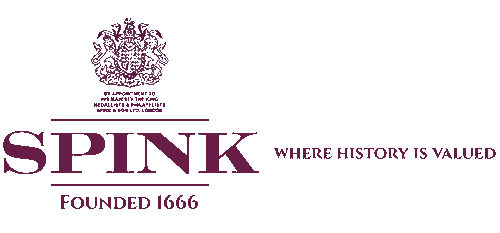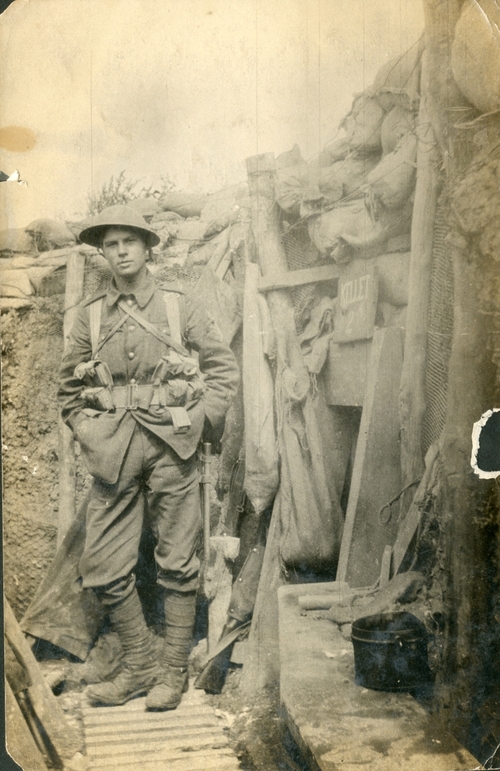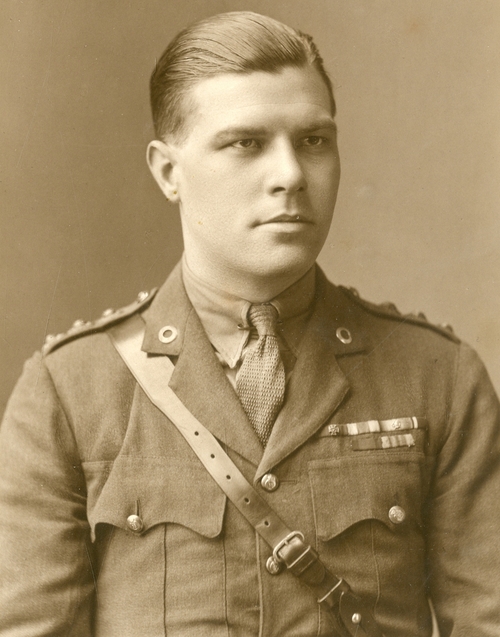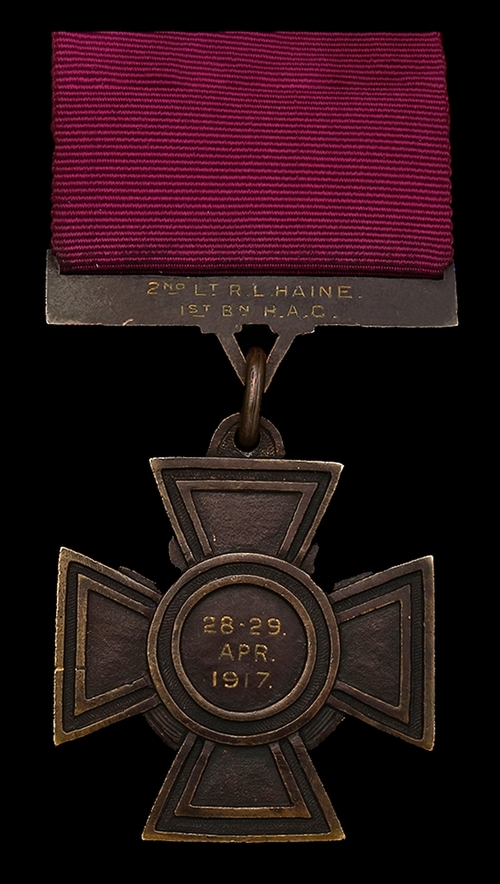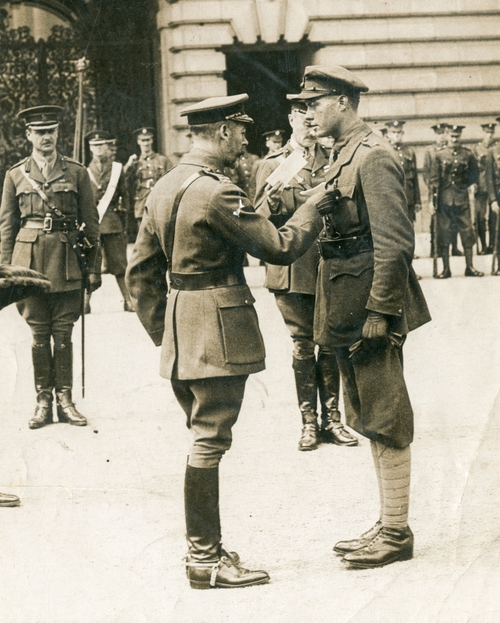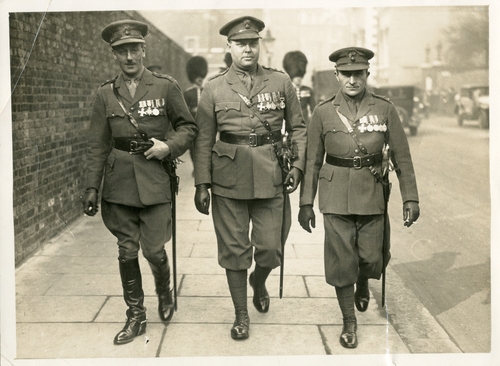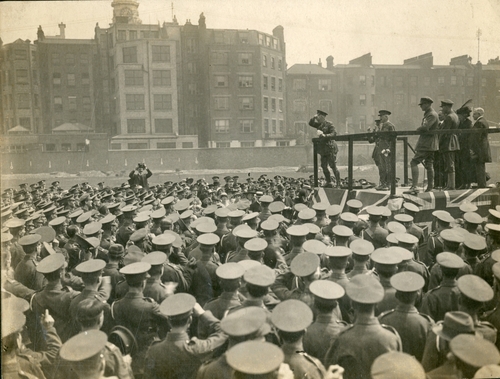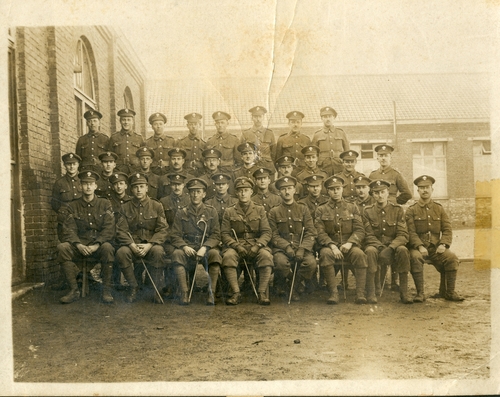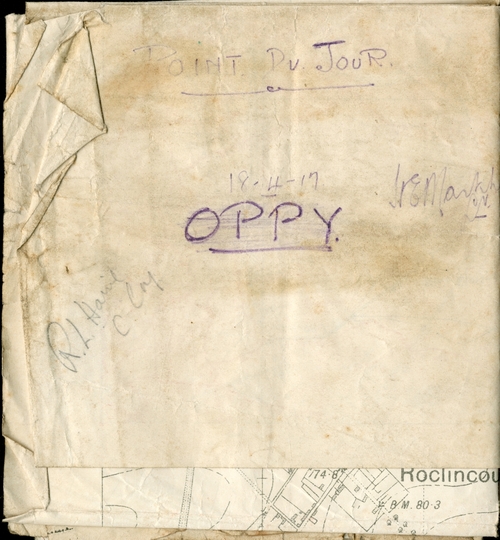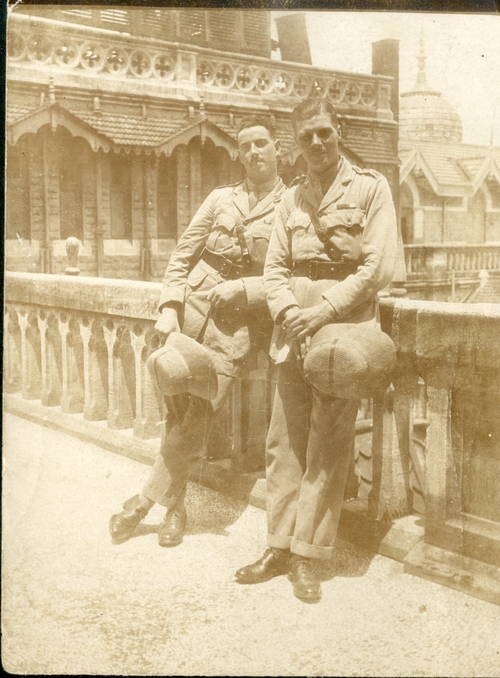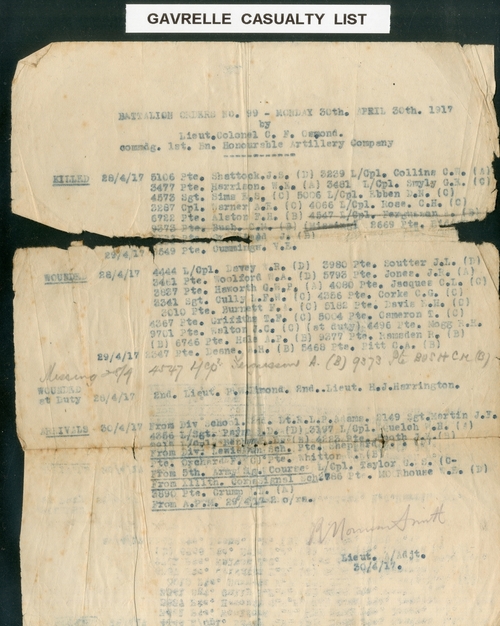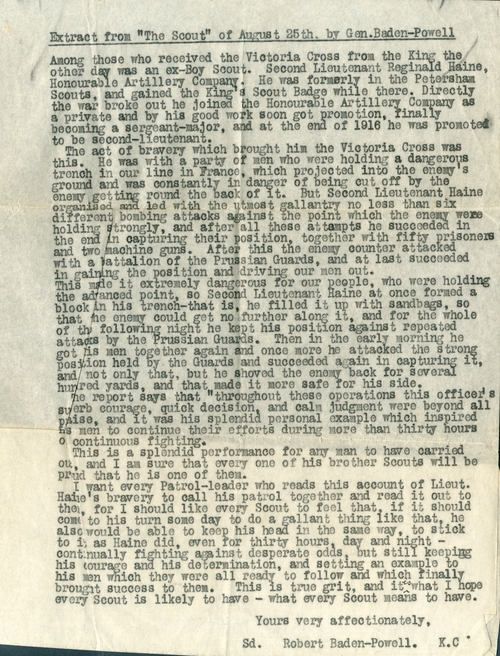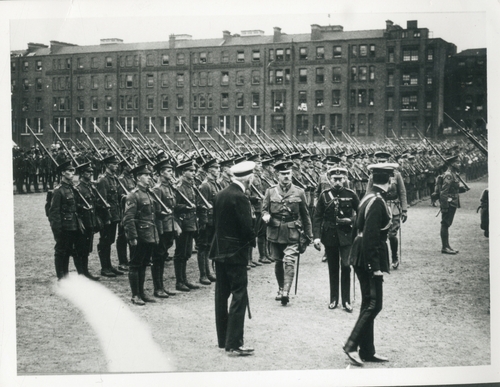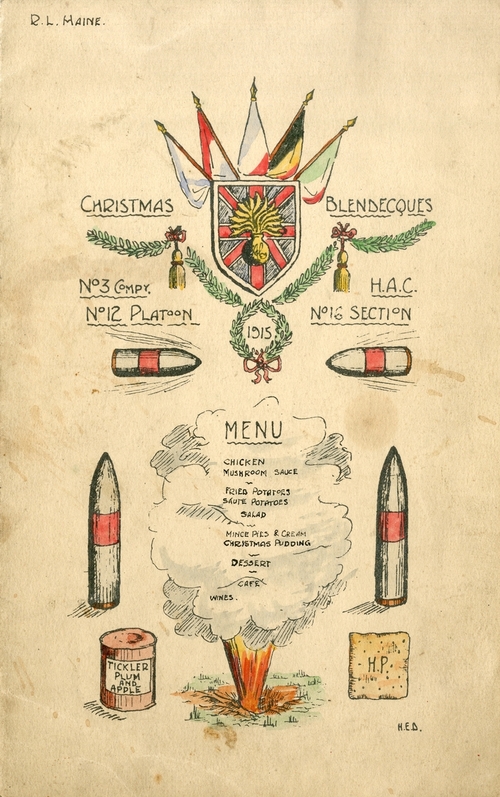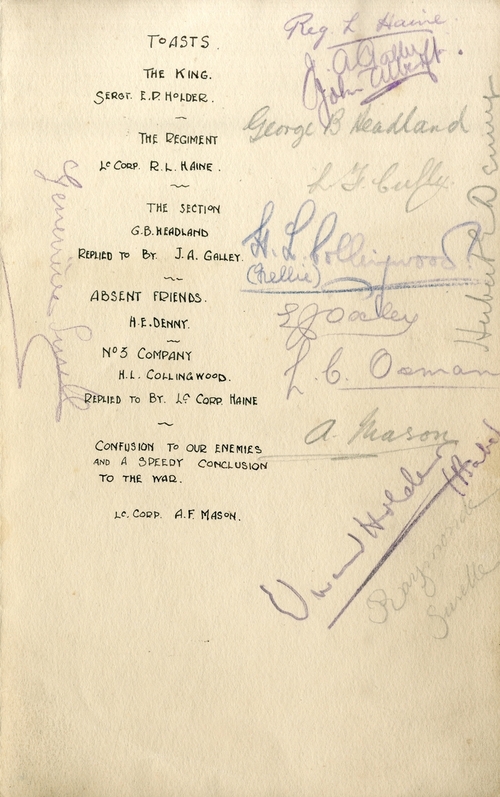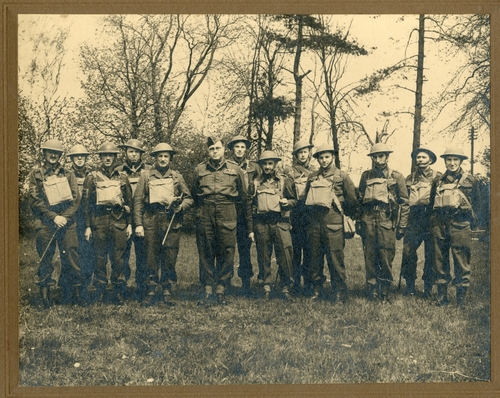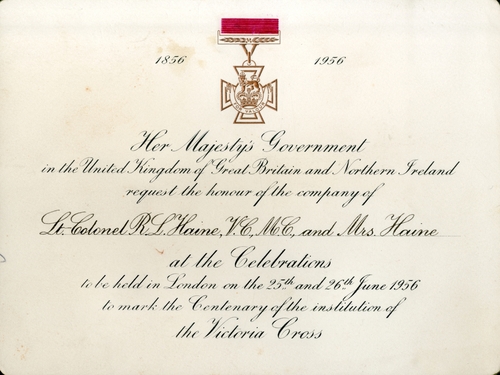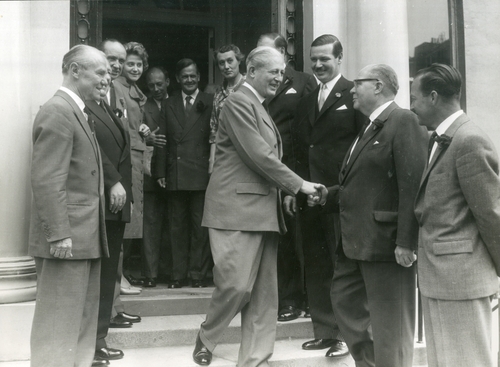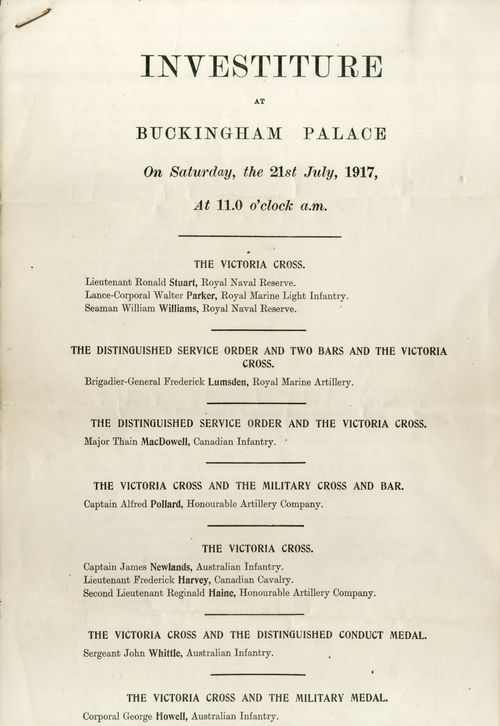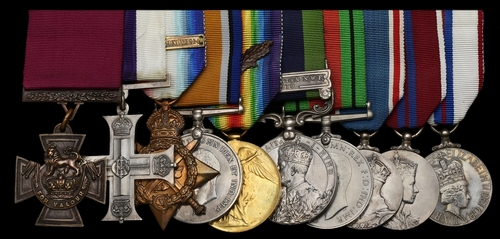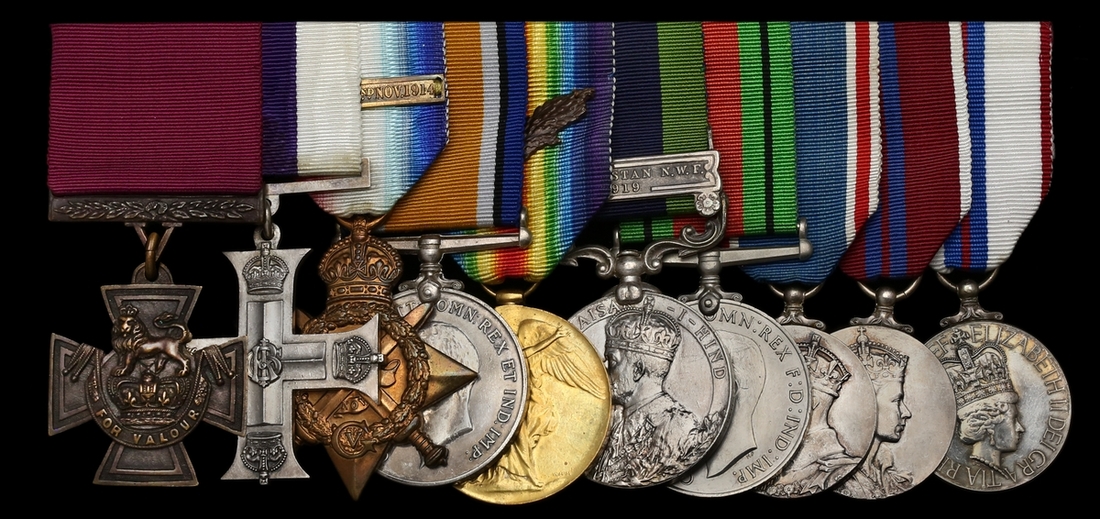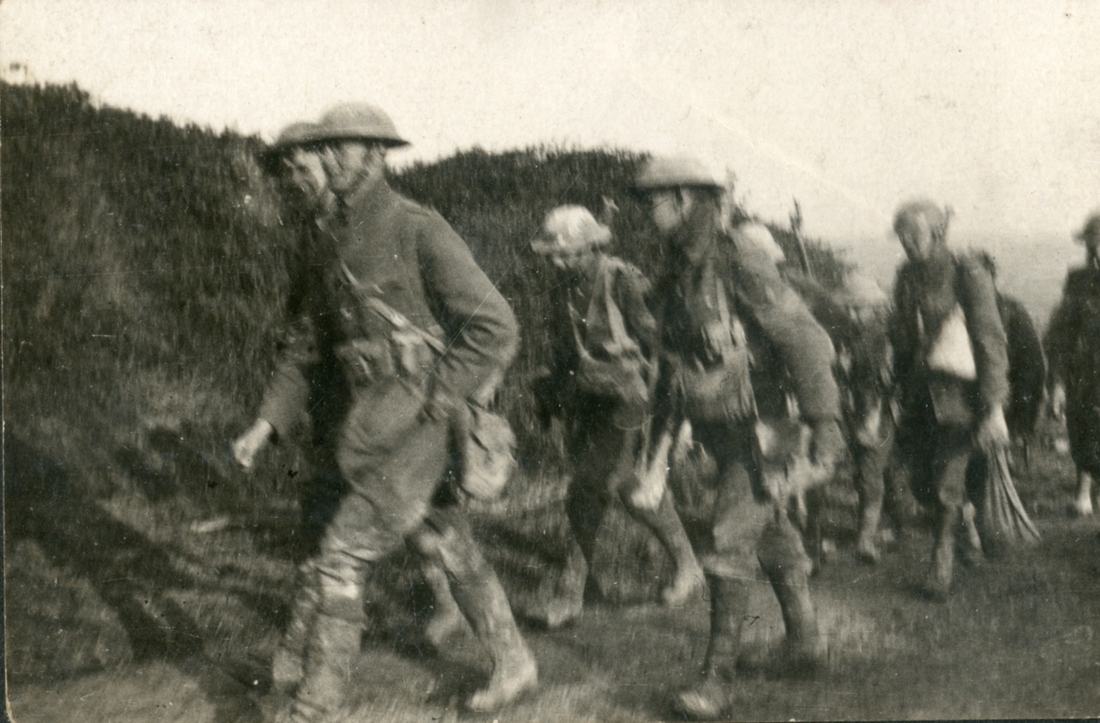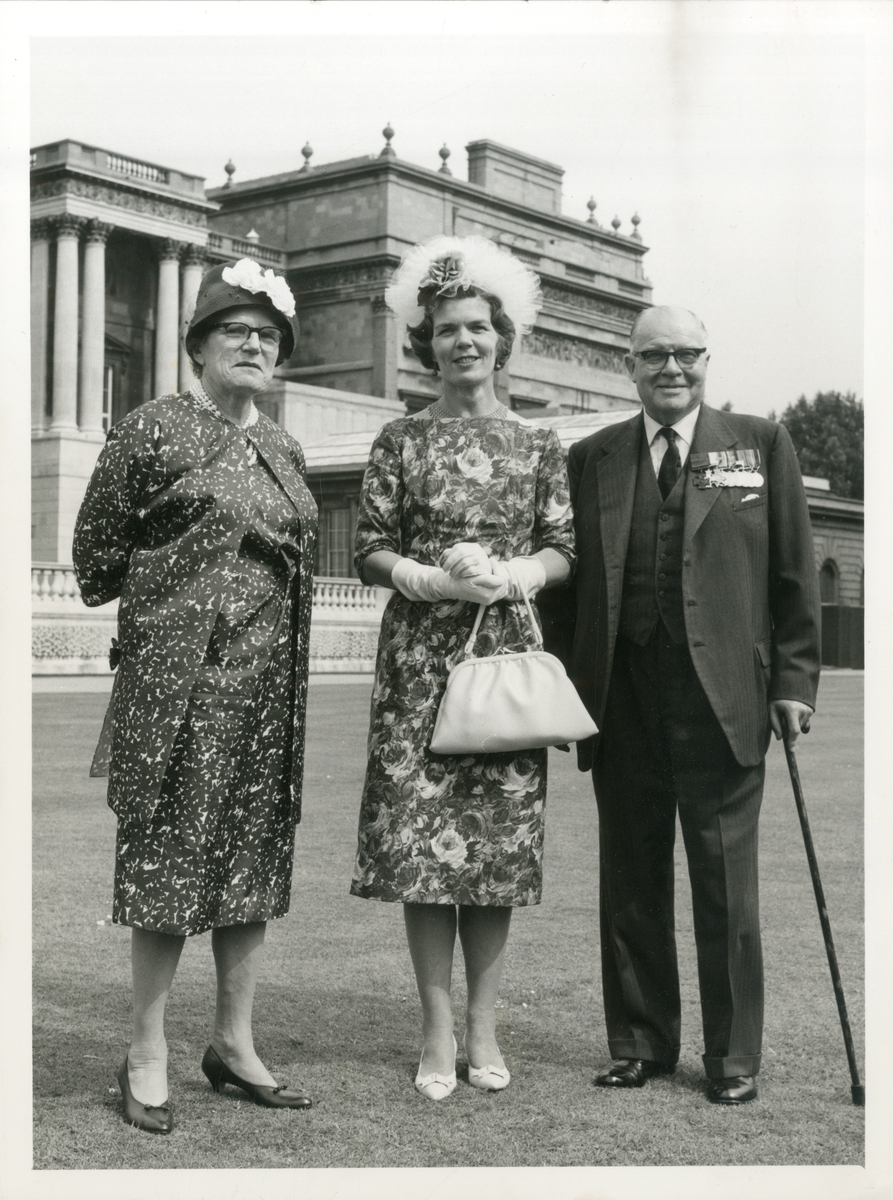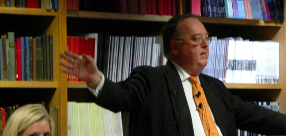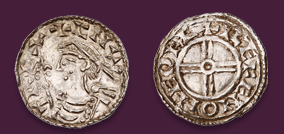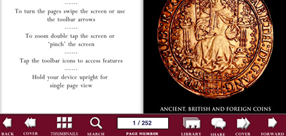Auction: 25003 - Orders, Decorations and Medals
Lot: 232
Sold by Order of the Family
'Still going strong and in the best of spirits.
Since I wrote to you last time, the Battalion has had a red letter day, or rather two days, the 28th & 29th April [1917]. For that period we fought the elite of the German Army, the Prussian Guards, and beat them, capturing about 80 prisoners.
By jove, they could fight, and it was a ding dong battle all the time. They were an awfully sporty crowd. "C" Company were right in it, & received messages of congratulations all round. This morning General Congreve, (the Corps Commander) the Divisional General, and the Brigadier inspected the Battalion. They seemed very bucked with us.
I was hauled before General Congreve, who made me explain the whole situation and congratulated me on the fine work done by my Company.
While the battle was going on, and just after we had a taken a strong point, I received a very nice letter from the Colonel, which I enclose. You might keep it.
Well, it would be hopeless to explain to you all the situation, so will now close.'
So wrote 2nd Lieutenant Haine to his parents on 1 May 1917, days after he had won his remarkable Victoria Cross.
The well-documented and important 'Battle of Gavrelle' 1917 V.C., Afghan North-West Frontier 1919 M.C. group of ten awarded to Captain R. L. Haine, 'C' (No. 3) Company, 1st Battalion, Honourable Artillery Company, who took his V.C. in the Battle of Arras with the 63rd (Royal Naval) Division
Having enlisted in the Honourable Artillery Company in August 1914, Haine rose up the ranks to become Company Sergeant-Major by late 1916; in this period he had been wounded in action in June 1915 and come through the Beaucourt action of November 1916, when his unit would capture 'The Mound' and push onto the objective itself with Lieutenant-Colonel Freyberg (latterly Lieutenant-General, 1st Baron Freyberg, V.C., G.C.M.G., K.C.B., K.B.E., D.S.O. & Three Bars, K.St.J.) at their head - Haine had miraculously also survived a heart-racing moment earlier that year when two comrades either side of him were shot dead in a split second
Having been duly commissioned 2nd Lieutenant, he was to have his finest hours on 28-29 April, when he and Lieutenant Pollard would write new pages into the history of his unit - one which went back to 1537 - in becoming the only two recipients of the Victoria Cross to date
Haine made half-a-dozen assaults on the Railway Post - a formidable concrete emplacement bristling with machine-guns and over 100 men - over two days of constant action, eventually capturing and carrying the position by hand; it was thus that gains were made that a whole Brigade had previously failed to secure
Not done with his haul, Haine transferred to the Indian Army and further gilded his laurels in earning a notable M.C. on the heights at Dakka in May 1919, returning to the fold as Colonel & Commanding Officer of the 58th (Purley) Surrey Battalion, Home Guard during the Second World War and was a founder member of the V.C. & G.C. Association
Victoria Cross, the reverse of the suspension bar engraved '2nd. Lt. R. L. Haine. 1st. Bn. H.A.C.', the reverse of the cross engraved '28-29. Apr. 1917.'; Military Cross, G.V.R., the reverse of the suspension bar engraved 'Capt. R. L. Haine. V.C. H.A.C. attd. 1/35th Sikhs.'; 1914 Star, clasp (1496 Pte. R. L. Haine. H.A.C.); British War and Victory Medals, with M.I.D. oak leaf (Lieut. R. L. Haine.); India General Service 1908-35, 1 clasp, Afghanistan N.W.F. 1919 (Lt. R. L. Haine, V.C, M.C. 1/35/Sikhs.); Defence Medal 1939-45; Coronation 1937; Coronation 1953; Jubilee 1977, mounted as worn by Spink & Son, good very fine (10)
Just 2 awards of the Victoria Cross to the Honourable Artillery Company to date. With the award to Captain Pollard held in the collection of the H.A.C., this is the only example available on the open market.
V.C. London Gazette 8 June 1917:
'For most conspicuous bravery and determination, when our troops, occupying a pronounced salient, were repeatedly counter-attacked. There was an ever-present danger that if the enemy attack succeeded, the garrison of the salient would be surrounded. 2nd Lt. Haine organised and led with the utmost gallantry six bombing attacks against a strong point which dangerously threatened our communication, capturing the position together with fifty prisoners and two machine guns.
The enemy then counter-attacked with a battalion of the Guard, succeeded in regaining his position, and the situation appeared critical. 2nd Lt. Haine at once formed a block in his trench, and for the whole of the following night maintained his position against repeated determined attacks. Reorganising his men on the following morning, he again attacked and captured the strong point, pressing the enemy back for several hundred yards, and thus relieving the situation. Throughout these operations, this Officer’s superb courage, quick decision and sound judgement were beyond praise, and it was his splendid personal example which inspired his men to continue their efforts during more than thirty hours of continuous fighting.'
M.C. London Gazette 29 November 1919:
'For conspicuous gallantry on 17th May, 1919, at Dakka. On many occasions during the fight near the summit of the hill he did everything in his power to collect the men for an attack on the enemy entrenches on the top in face of very heavy fire. When it was decided to retire and take up a position further down the hill, he collected all the men he could gather, and, before descending, assisted in getting all the wounded away.'
M.I.D. London Gazette 18 May 1917.
Reginald Leonard Haine was born on 10 July 1896 at Wandsworth, London, the second son of Harry & Louisa Haine. By 1901 the family were living at 10 Wilma Road, his father being a Detective Sergeant in the Metropolitan Police. A schoolboy in 1911, the family moved to 9 Sheendale Road, Richmond and young Haine was a keen Scout. He had joined the Ham & Petersham Troop and is recorded as a Patrol Leader, in which role he would have shared in the Coronation Festivities that year. He was also educated at Richmond School until the age of seventeen, when other events would overtake his young life.
Great War - into the fold
Haine joined the Honourable Artillery Company at Armoury House on 24 August 1914, at that time articled to a firm of accountants. He recalled his joining:
'A friend phoned me (on the Monday morning) and said, 'What are you doing about the war?' Well I had thought nothing about it at all.
He said, 'I have joined my brother's regiment, which is the Honourable Artillery Company. If you like come along, I can get you in.'
At lunchtime I left the office in Southampton Row, went along to Armoury House in the City Road, and there was my friend waiting for me. There was a queue of about a thousand people trying to enlist at the time, all in the HAC - it went right down City Road. But my friend came along the queue and pulled me out of it and said, 'Come along!' so I went right up to the front, where I was met by a sergeant-major at a desk. My friend introduced me. He, (the Sergeant-Major) said, 'Are you willing to join?'
I said, 'Yes Sir.'
He said, 'Well, how old are you?"
I said, 'I am eighteen and one month.'
He said, 'Do you mean nineteen and one month?"
So I thought a moment and said, 'Yes Sir.'
He said 'Right-ho, well sign here please. You realise you can go overseas?'
So that was my introduction to the Army.'
He was to serve in France with No. 3 ('C') Company, 1st Battalion from 18 September 1914. Having made their way up the lines, he first came under fire as recalled in a letter home:
'Just a line to let you know that all is going well the weather is not exactly what you would call fine, and we had a little snow this morning. I have had no time to write a letter to you before, but will try and let you know some news now. Since my last letter, we have had one or two shifts and we are at present stationed at village a few miles behind the firing line. The other night we acted as reserves in some night operations. There was little excitement, our guns blazed away behind us, and the shells came whistling over our heads towards the Germans. There was little reply from the enemy, and we left the trenches before day-break. For the last three days we have been used for digging reserve trenches behind the firing line. This is much more exciting work, for we do it in daylight when the guns are going on both sides. You can hear the shells come whistling along. You are immediately dived down to the bottom of the trench and await results. The day before yesterday we had about a dozen "Jack Johnson's" burst not more than 70 yards from us. The debris from each whizzed overhead.
Yesterday morning we had shrapnel over us. One shell burst right over our trench, killing one of us and wounding eight or nine more or less seriously. One of the wounds I'm afraid is fatal. I was lucky to escape uninjured as the man on my left was hit in the head, and the man on my right got one in the leg and one in the wrist. I escaped with a slight scratch on my left hand, and I got some in the back by what I expect was a clod of the earth. I have got a souvenir (as we call them) in the shape of a double hole in the sleeve of my tunic where a piece of shrapnel went. We have done with the trench digging for the present, and I believe we are shifting shortly.'
He would write of time in the Front Line in late November 1914:
'I have at last got time to sit down and give some account of myself. As a matter of fact, the grade of which Regiment is part has come down for a few days rest.
During the past week we have been working in shifts in the firing line. Our company has been in twice on Sunday last we left our billets at dusk, And went into reserve till 4 o'clock in the morning. We then advanced silently as possible over the snow into the first line of trenches. There was very little doing till dawn, and we had ample time to make ourselves comfortable.
During the whole of the day there was a heavy artillery duel, but most of the German shells went over us. The enemies trenches were about 450 yards yards away, and their snipers are all over the place on the lookout for the unwary. The trenches we go into are quite comfortable. They are lined with straw, and "funk holes"(that is holes dug in the side for protection from shrapnel) are already cut. We take a blanket with us and are allowed to light a charcoal fire.
Towards evening the shellfire slackened off, during the whole of the night there was the sultry firing. Task, guards are mounted and those of duty trying to get to sleep. We were relieved at 4 o'clock the next morning (after 36 hours duty by another regiment.'
Having come through these early trials, he found himself in No. 13 General Hospital in June 1915:
'We had a very hot 24 hours last Wednesday. At daybreak the guns knocked spots of their trenches for a couple of hours, and when we charged, they absolutely funked it and ran like a lot of rabbits. We got their 4 lines of trenches, but the fourth line was hopelessly enfiladed, so it was evacuated later in the day, and we hung on to three lines. They did take some hanging on to, I can assure you. Directly we occupied their trenches, soon after 4 a.m. they commenced a terrific bombardment, which, up to the time I came away, had lasted 22 hours, and was still going on. The position was right at the point of a salient, so that the guns of the Germas more than half circled us, and it was almost impossible to tell which were their guns and which were ours.
When we charged it was impossible to see the Germans' trench in front, because of the thick fog of smoke made by bursting shells. When being attached, it is in their method, as well as ours, to make a screen of shrapnel between the trenches. While charging, however I was unconscious of this. The only thing I can remember is the zipp of machine gun bullets whistling past. We started at a trot, and finished walking. We had been detailed off to odd various jobs - some to reverse the parapet of sand bags, others to reverse barbed wire and others to guard the prisoners. I was detailed for the last named job, but as we didn't take many prisoners, I helped with the sand bags. While at this job I had the two fellows on my right killed by machine gun fire. I was bending down at the time and escaped. It was not so bad while we had something to do, but after we had consolidated the position, all we could do was to sit and wait. Under the terrific shell fire it seemed impossible that anyone cold come out alive, but I assure you that several of us did.
They were using an "une speciatlité" on our side of trench, a battery of 12" howitzers, besides a lot of 8.9's and goodness knows how many whizz bangs. While keeping guard during the afternoon a 12" landed a few yards off. It was H.E. Shrapnel, and I was fortunate enough to get a shrapnel bullet clip the top of my finger (left hand, second finger). The wound is nothing at all, and I am very lucky to get down to base. The bullet knocked off most of the nail. and I am afraid the rest of the ail will soon be "non est". I went and sat down for a bit. It was late afternoon when the bombardment was much worse.
It is said that in our bombardment of the morning, we used more than 300,000 shells on a 1000 yd. front, and I should thing that in the afternoon the Huns used quite as many, of not more than we did. It was really awful. Towards evening, a great big "crump" landed on the parapet above me, and three of us were buried. With considerable difficulty, I succeeded in clearing myself of the sand bags and other debris. I found the shell head, weighing a pound or two, right touching my body. Lucky, wasn't it!
The other two chaps, one of whom had already been wounded, were unable to get out, so I had to help them. The Huns shrapnelled the gap made in the parapet continuously, and put over a gas bomb. I thought my number was up at that time. I got one fellow out, and uncovered the other, but the sandbags on his legs were too heavy for me to lift. Nearly everybody in this part of the trench was laid out, but I at last got assistance and got this chap out. Twice during the afternoon the Huns prepared to attack, but our artillery mainly stopped them.
After dark they gassed us with gas bombs, but our smoke helmets were very effective. They attacked feebly and were driven back like chickens. That is all I know. Three of us left some time during the night. We were all slightly wounded. We tried to go by communication trench, but it was bunged up with dead, so we cut across the fields to a dressing station about 2 miles behind the lines. They were shelling round about this part, and it was crowded out so we went on. We passed through a ruined town, and on to the main dressing station. From main dressing station, I went by motor ambulance to field hospital. From field hospital had a motor bus ride of 15 miles to clearing hospital and from clearing hospital by train to here - all for a hit on the finger. Well, I'm having the time of my life, and so I can't grumble.'
Recovered and back to his unit, Haine was steadily promoted. The thought of a commission was also something that had been suggested and was clearly of interest. His papers were submitted for a commissioned into the Artillery. News however filtered back that a new Army Order had come down '...which states that no infantryman can take a Commission in Artillery, and vice versa.'
So it was he would be put forward for a commission in his own unit:
'Still going strong. You will be pleased to know that I have been promoted to Company Sergeant Major, and letters should now be addressed 1496, C.S.M. Haine.
Re Commission, I have been interviewed the Brigadier General, who approves, and with luck, the commission should be through in a little while, probably a matter of days. This is a topping little place we are in, and we are settling down very well. I only hope we shall stay here for a few weeks. When my Commission comes through, I shall have to scrape together some clothes. A very good motto is, "little but good". You do not need a very elaborate kit out here, but you want good stuff. Our officers uniform is the same as that of the Grenadier Guards. When gazetted, you are credit[ted] with £50 from Cox's bank.'
Beaucourt - hot action
Haine and the 1st H.A.C. shared in the costly actions at Beaucourt-sur-l'Ancre on the Somme from 13-14 November 1916. The unit at had formed part of 190th Brigade, 63rd (Royal Naval) Division and were tasked to capture "The Mound," a German position on the northern bank of the Ancre river. The troops were to clear the railway line to secure the far-right flank of the attack and then push for the village itself. In the final act, Lieutenant-Colonel Bernard Freyberg, commanding the 190th Brigade, led a composite force which included the H.A.C. to press home the victory and was wounded in the process. Haine tells his part best:
'I expect you will be wondering what has happened to me, as I have not sent a letter for such a long time. As a matter of fact, it has been absolutely impossible to get a line, or even a P.C. through to you, as the regiment in on the march and separated from the Post Office.
I wrote a letter to you about 5 days ago, but have been unable to post it, I am going to try get this letter home by somebody going on leave.
Well, we were in a big scrap last week. (on the 13th and 14th). We went over the parapet twice in two days, and on the second day we took the village of Beaucourt, and well over a thousand prisoners. Not so bad eh? We had been down on the Somme since September but it was the first time the Battalion had been properly in action.
The Regiment did magnificently, and won praise. All round. Considering the work we did, our casualties were few, about 250 - 300.
I had a very good luck myself. One sniper dented my tin hat, and shrapnel also dented it, but I came through untouched.
After we have been in action for 15 minutes, our Company had lost all officers, except one 2nd Lieutenant. And also the Sergeant Major, so I found myself 2nd-in-Command of my Company. We took Beaucourt very easily, with few casualties. The Huns were frightened and gave up readily.
Well we are not well down the line and going further. We are doing about 10 miles per day, our final destination is a place called Rue, which is quite near the sea, by the mouth of the Somme. Here the Division will refit and reorganise.'
He followed up on 2 December 1916:
'Just a line to let you know I am going along all right. The mails appear to be very much delayed, and it takes about 8 or 9 days for your letters to reach me. By the way I received your parcel containing sweets, etc. and I believe that I acknowledged same in one of my letters.
I am having a rather good time as Company Sergeant-Major. I have now got a servant, called in army terms, a batman; and also a runner to do any little odd messages. It has been very cold and frosty lately, and I am very glad that we are not in the trenches.
Re Commission, I am afraid that I shall not be sent home to train, as you suggest, but shall be posted straight to the battalion. However, with luck, I should l get leave after some little time, at least, considerable sooner that I should get if I had not taken a Commission. By the way, leave is now 8 days, which is much better.'
Haine was officially listed as a 2nd Lieutenant on 6 December 1916. He clearly had taken - or been the one to claim the film - a camera into the trenches with him, as the results came back from his parents in December 1916 (and survive to be reproduced today):
'I was very glad to receive your letter yesterday, enclosing photos etc. I am glad that the one of the Huns surrendering came out, even if very dimly. You will notice that two or three of the Huns are wearing their new shrapnel helmets, a big affair, which comes down over the ears. There are two English, (our Regiment) on the photo, on the left. The rest are Huns. You will notice that a lot of the Bosches are minus head gear, doubtless taken for souvenirs. I remember very well seeing the chap furthest left on the photo, he had been probing about, and had skewered a huge German sausage on his bayonet. You can see it quite plainly in the photo.
The photo of troops marching, was taken the day we were coming away from the "stunt". It was taken in a road, that, two days before, you would not have dared to show your nose. The chap nearest the camera, with his hand in his pocket, was the only officer of our Company who got through it.'
1917 - finest hour
As the year dawned, Haine found himself in temporary Command of No. 3 Company after the death of Lieutenant-Colonel Ernest Boyle D.S.O. in action, who had the honour of being the highest rank of the H.A.C. to lose his life on 7 February 1917. Detailed for a stint of training at 5th Army Trench Mortar School to brush up, he was back with his beloved No. 3 Company before long. On 13 April he confirmed:
'Still going strong. I have had a busy time lately training etc, but expect to be moving shortly, so don't get anxious if you receive no news. Am again in charge of "C" Company, and the trusty charger. Getting quite a horseman these days. I find the big top boots are a great help, as you can get a good grip with them.'
In the middle of that month, the Royal Naval Division did indeed get moving. They swapped out the 34th Division who were in front of the village of Gavrelle, in the strong-held Hindenburg Line. With the 4th Battalion, Bedfordshire Regiment and 10th Battalion, Royal Dublin Fusiliers having attempted to push the Brigade outposts into a straighter line on 15 April, their attacks ground to a halt. Thus the H.A.C. and the 7th Battalion, Royal Fusiliers went into action on 16-17 April. The attack carried and the 189th & 190th Brigade fronts could be linked. It wasn't a simple victory as they were charged to attack along the forward pitch of the Gavrelle Plain in direct view of their enemy. Not only that but they went into action in freezing and frigid conditions, with precipitation a mix of sleet and snow. Haine wrote on 25 April 1917, just 48 hours before his most famous actions:
'Still going strong and feeling very bucked with life. Since I wrote to you last, about a fortnight ago, we have been more or less "in the soup", but all's well that ends well, and here we are out of it again. I have not had the slightest chance of sending a letter to you but hope that you have received my two "panic p. cs.". We moved up to the trenches on Saturday, the 14th instant, and immediately took over apportion of the line which had been taken by us a day or so before, and south of the famous ridge. We were "up" for about 9 days and did quite a lot of little stunts, such as advancing for a 1000 yards or so in daylight, and at night pushing our line right up to within 200 yards of the Hun and digging ourselves in. Your humble had the responsible job of Company Commander, a very trying task in such warfare, as you have got the lives of about 120 men depending on you. After nine days we were withdrawn to reserve. Arrived back at 5am one morning and went up again the same evening to do a "stunt". On Monday the 23rd the Brigade went over the bags our Battallion being in support. By the same evening I found myself on the extreme left of the attack we had broken through and taken a very powerful line and a village. I don't know what happened further south but round about or place everything went very well. It's rather awkward being on the flank of an attach, because, if you push for any distance, you have to swing round and guard your flank, at one point you must be in the same trench as the Hun. This is what happened in our case, and my Company had a very mixed pleasure of being in very close company with the brother Bosch. Nothing happened much during Monday, except that we bombed the Bosch back about 200 yards, and Tuesday morning was very quiet. The fun started on Tuesday afternoon when we saw crowds of Huns emerging from a wood about a mile and half away, and advance towards us. Before you could say knife our guns had opened out and were pounding away. They tell us that 6 Hun Battalions were attaching and coming for a N.E. direction so as to get us on the flank. Our guns were wonderful. The light guns put up what is known as a Box Barrage. This more or less explains itself. It was a barrier of shrapnel and H.E. right round the unfortunate Huns. Then right smack into the lot of them we plumped heavies. For the first time of my life I saw them wiped out in large batches. The Huns extended and came on in fragments. When they got close enough our Lewis Guns (automatic rifles) and machine guns opened on them, and all our fellows had a high old time with their rifles. I don't believe one Hun got within 600 yards of us. The whole attack broke down and the remnants of those 6 battalions retired in disorder. I have heard that, at a rough estimate the enemy left 3,000 dead. The casualties for my company were one killed and one wounded! A little later on brother Bosch tried to drive in our flank along the trench, but after getting a couple of bombs retired quickly if not gracefully. It was a wonderful day and it sent the men's spirits right up to the top pitch. If that is an example of Hun generalship making an attack on a bright afternoon with masses of troops. The ground open in front for miles, and practically no artillery preparation; it's just about time Germany thought of giving up war and starting to play marbles. Our chaps treated the thing as a hight joke and made tea at teatime as if they were a thousand miles from the Bosch. Simultaneously with receiving a message from my flank that the Huns were attaching our left flank, my orderly brought me a cup of tea! What a life!..This letter is more or less private and confidential. My C.O. has put my name in for a fortnight's rest. Jolly good of him, as only one place is allotted to the Battalion. Perhaps it will be on the coast.'
Railway Post - V.C.
Haine never got his leave. On 24 April, the Prussian Guards had put in a huge attack which re-took Gavrelle, with the H.A.C. being relieved by the 2nd Battalion, Royal Marine Light Infantry. His unit was to remain in the Black Line until 27 April.
Orders had come down that the German lines which ran out from Gavrelle to Oppy Wood in the north. Haine and his No. 3 Company would be used to bomb out a strongpoint, known as Railway Post, a concrete position on the railway line which ran between Bailleul and Vitry. It was formidable and was crammed with machine guns and could garrison over 100 troops. It was a tall task which faced Haine and his comrades.
Three gallant attempts were made by No. 3 Company to carry the post. Men dropped around him but as recalled in his citation, he continued to attack. Calls for assistance from Stokes mortars were requested but the support was taking far too long. With the assistance of Lieutenant Pollard's No. 4 Company, Haine was finally able to push home and capture the Railway Post. He found it was honeycombed, not only filled with gun posts but with a deep dug-out. It was not the end of the action, however, for a strong counter-attack began to play out. The elite Prussian Guards came down from Oppy and forced them from their position. No. 3 Company was now just a dozen strong, the survivors clinging to the gallant efforts of Haine. They had no choice but fall back south of the railway line that night.
The actions of the Royal Naval Division at the Battle of Gavrelle Windmill during the wider Arras Battle is something which has gone down in the history of all those who shared in it. The 1st and 2nd Royal Marines Light Infantry could count over 1,000 casualties in those two days. Similarly to the events playing out around the Railway Post, in another sector during an overwhelming enemy counter-attack, the tide was only stemmed by the senior officer enlisting the assistance of his H.Q. Staff, cooks and bottlewashers.
On 28 April, the Naval Division had held firm during at least seven attempts to push them off the village itself. They hardly lost a yard. Artillery fire was at such short ranges to be devastating to those who were unfortunate enough to participate.
Haine, however, had only begun to show his true colours. Called to Battalion HQ - which was but a few yards up his trench - by Lieutenant-Colonel Osmond in the early hours of 29 April, he was charged to assault Railway Post again. It was to be, at the sixth attempt, that he finally carried the position and could add a good haul of Prussian Guards to his bag as Prisoners of War.
The day was not done for him yet, although the following letter came to his post at 0855hrs from Lieutenant-Colonel Osmond:
'To O.C. "C" Company H.A.C.
My Dear Haine,
The G.O.C. informs me that the Divisional Commander wishes to convey his very hearty congratulations to you, and the officers and men of your Company, who have twice taken the strong point in two days. The Brigadier especially wishes to add his personal thanks for all you have done.
I need not tell you how proud I am of every one of you or how certain I was that you would take it if it was humanly possible.'
To prevent any further attacks, Lieutenant Pollard went through the position and set up his own post some way to the north to allow Haine to consolidate. Pollard, an expert bomber, then held off with a handful of men and further cleared an extra 300 yards. Both Haine and Pollard took their V.C.'s for their own part, the only two awarded to the Honourable Artillery Company to date, a unit formed by Royal Charter in August 1537.
Relieved by the 13th Battalion, East Yorkshire Regiment, the exhausted men marched back to Roclincourt and took rest under canvas. Haine wrote to his parents on 1 May:
'Still going strong and in the best of spirits.
Since I wrote to you last time, the Battalion has had a red letter day, or rather two days, the 28th & 29th April. For that period we fought the elite of the German Army, the Prussian Guards, and beat them, capturing about 80 prisoners.
By jove, they could fight, and it was a ding dong battle all the time. They were an awfully sporty crowd. "C" Company were right in it, & received messages of congratulations all round. This morning General Congreve, (the Corps Commander) the Divisional General, and the Brigadier inspected the Battalion. They seemed very bucked with us.
I was hauled before General Congreve, who made me explain the whole situation and congratulated me on the fine work done by my Company.
While the battle was going on, and just after we had a taken a strong point, I received a very nice letter from the Colonel, which I enclose. You might keep it.
Well, it would be hopeless to explain to you all the situation, so will now close.'
That '..very nice letter from the Colonel' accompanies the Lot. News of the award of his Victoria Cross would appear in June 1917, going up to Buckingham Palace to be presented with his reward from the hands of The King - the Captain-General and Colonel of the Honourable Artillery Company - on 21 July 1917.
Haine and Pollard then went on to a Celebratory Lunch at Armoury House, put on in their honour. All the available Artillery & Infantry mounted a Guard of Honour and led them through cheering lines to a platform in the middle of the Drill Ground. Accompanied by their parents and a group of senior officers, including General Sir Harry Mackinnon and Colonel the Earl of Denbigh and Desmond, who was Commanding the Honourable Artillery Company, they were feted for their efforts and then went inside to dine. In line with the self-effacing men of that generation, when Pollard was asked to speak, all he said was “Thank you very much everybody” and sat down. The audience were not impressed and asked Haine to elaborate. He stood up and followed “I think Alf’s [Pollard] said all there is to say” and promptly sat down. Richmond Council also wished to raise a subscription in his honour - that was also turned down. Haine did not see any link between his actions and a personal monetary return.
Indian Army - further laurels
With the Great War coming to a close Haine - by now a Lieutenant and on a train to Italy - was looking towards his future employment. He went for an interview in order to be given a permanent commission into the Indian Army in September 1918. Having passed, he was seconded in November 1918 and was confirmed in January 1919.
Joining the 1st Battalion, 35th Sikhs, he would see further active service during the Third Afghan War, as part of the 2nd (Rawalpindi) Division. He was once again to find himself in the thick of the actions around Dakka and further added to his medallic haul, as recorded by the National Army Museum:
'Dakka was initially occupied by the British on 13 May 1919, but Brigadier-General Guy Baldwin's choice of camp location, near Loe Dakka, was poorly suited for defence and he failed to secure the surrounding heights. Two days later, Major-General Charles Fowler arrived at Dakka and assumed command. He ordered the camp to be moved two miles further west and made an effort to picquet the hills to the south and west of the camp. But before all of these improvements could be made, the camp came under artillery barrage and then an infantry assault.
This Afghan attack was defeated and the British launched a counter-attack the following day, however, they were unable to consolidate their position and it was not until 17 May that the heights around Dakka were finally secured and the Afghans forced to withdraw.'
The 1/35th Sikhs, along with 1/9th Gurkha Rifles, Somerset Light Infantry and support from the King's Dragoon Guards won the battle. On that occasion a large force of some 2,000 Afghans, including 2 Cavalry units advanced to strike the British camp - they opened fire from the heights with rifles and artillery and put in a dangerous night attack at 9 p.m. which at one point threatened to overrun the defenders. Having forged together, the British forces the next morning charged and forced the high ground, inflicting heavy casualties - some 300 dead - and sending the Afghan raiders into retreat. It was the efforts of the gallant Sikhs and individual efforts of bravery such as Haine which ultimately turned the tide of battle.
Made Adjutant of 1/35th Sikhs and acting Captain from late May 1919, Haine returned to Buckingham Palace to get his M.C. on 10 March 1920, having been released from the Indian Army in January 1920. Advanced Captain in the Honourable Artillery Company in January 1928, he joined the Reserve of Officers in June 1929.
Home Guard - back for more
Having taken the preliminary examination in 1913, Haine qualified as an accountant and was a member of the Baltic Exchange from 1922-53. It can be no surprise that with the outbreak of the Second World War that he was to return to uniform to assist. He served as Commanding Officer & Colonel of the 58th (Purley) Battalion of the Surrey Home Guard from January 1941, having been married there in November 1923. The unit were associated with The Queen's (Royal West Surrey) Regiment and wore its cap badge. He was clearly a man adored by those who served under him - the archive of glowing original letters which accompany the Lot further confirm this - and one who inspired his charges. He began as commander of No. 1 Battalion, Purley and was the senior representative at the funeral of 61 year old William Battle. Battle was a member of the unit on duty at the Kenley Waterworks and was killed in action on 18 August 1940, when the Luftwaffe bombed RAF Kenley. Further details of the exploits of his unit can be found in A History of the 58th Surrey Battalion Home Guard.
A founder member of the VC and GC Association in 1956, Haine would latterly sit on its Committee. He was also Chairman of the Baltic Exchange Branch of the British Legion, meeting in Merchants Hall, London. Moving out to live at Dawsley Cottage, Hollist Lane, Midhurst, Sussex he was married for nearly 60 years to his loving wife Dora. They had a daughter and three granddaughters.
The good Colonel died at St Thomas's Hospital on 12 June 1982. A funeral was held at Easebourne Church and he was cremated that day.
His 1914 Star was issued in December 1919, the Great War campaign medals were claimed in February 1921, his I.G.S. was issued by the Government of India in May 1922, whilst the clasp to his 1914 Star was not issued until February 1961, when it was sent to him at home in Sussex. A book based on his letters, diaries & photographs is in production and will be published in the near future.
Sold together with the following extremely comprehensive archive, of exceptional and historic importance:
i)
The recipient's original Commission document, made out to: 'R. L. Haine, Second Lieutenant, Territorial Force, Honourable Artillery Company (Infantry)', dated 7 December 1916 and signed 'George R.I.', together with the recipient's original Mention-in-Despatches certificate, made out to: '2nd Lt. R.L. Haine, 1st Coy., Honourable Artillery Company (T.F.)', dated 9 April 1917.
ii)
Seven original military maps owned and carried by the recipient during the Great War, including two of the seven specifically marked: 'R. L. Haine, C. Coy.' and 'O.C. C Coy.' respectively, and four of the seven with very detailed annotations of trench networks and key features; the village of Gavrelle heavily underlined in red ink on one map.
iii)
Two original reduced-size diaries, written by the recipient on the Western Front during 1914-15; his message book from his time on campaign on the North-West Frontier of India; the original War Diary of the 1st H.A.C. (Infantry) from 20 - 30 April and 14 - 31 May 1917; and his original Soldier's Pay Book.
iv)
No fewer than 192 original photographs of the recipient, comrades, and related scenes on the Western Front and in uniform during the Great War (many of these annotated and unpublished) including life in the trenches; H.M. The King's Inspection of the H.A.C. at Armoury House on 12 September 1914; the Regimental Reception held for Haine and Pollard at Armoury House on 21 July 1917; a series of informal snapshots of an H.A.C. 'old comrades' battlefield tour circa 1925; and a fine portrait-style photograph of the recipient in uniform whilst an officer in the 35th Sikhs.
v)
A file containing no fewer than 67 typed transcriptions (probably compiled circa 1950) of letters written by the recipient on the Western Front to his parents at home, dates ranging from 1914 - 1917 and some referenced above, comprising a fascinating amount of detailed, eye-witness primary source material of Haine's experiences in the trenches; additionally seven typed letters written to the recipient by a military history researcher in the U.S.A., dated 1979, with further interesting personal recollections of Haine's experiences of the Great War.
vi)
Eight documents relating to the recipient's award of the Victoria Cross and the action at Gavrelle including: an original list of those presented with the V.C. (and other awards) at Buckingham Palace on 21 July 1917 (noting both Haine and Pollard); typed transcripts of Haine's citation for the V.C.; casualty list of the action at Gavrelle; Battalion Orders issued to Haine as Officer Commanding 'C' Coy.; an extract from 'The Scout' written by Robert Baden-Powell detailing his praise for Haine's actions; a congratulatory letter from the Institute of Chartered Accountants; a congratulatory (hand-written) letter from the Commanding Officer of the H.A.C; a framed congratulatory letter to Haine from Major Osmond in the aftermath of the action at Gavrelle; and a silver hip flask, hallmarks for Sheffield 1918, engraved to the front with the initials 'R L H'.
vii)
Five menu cards relating to H.A.C. dinners: one 'in the field' in 1915 and most attractively designed and coloured, the remainder for the post-war 'Westmeath Dinner' with the latter all profusely signed by fellow attendees, including the official programme for the H.A.C. Reception at Guildhall on 14 July 1937; two further H.A.C. booklets; a print of the Menin Gate; and a newspaper cutting of the Prince of Wales's visit to Guildhall in 1922.
viii)
Two cassette tapes, recording the recipient's interview with the Imperial War Museum's Department of Sound Records in 1976, together with two copies of the typed transcript entitled: 'Western Front: Life and Operations 1914-1918' running to some 40 pages.
ix)
No fewer that 107 original photographs of the recipient's travel to - and service in - India with the 35th Sikhs, some contained in original albums but the majority loose, including informal snapshots and frontier scenes, some annotated; a notebook-diary covering the dates January - July 1919; three regimental Christmas cards; an 'H.A.C. Dinner' menu card from the Peshawar Club, dated 5 April 1919; and a receipt for the Taj Mahal Hotel.
x)
A quantity of original archive material relating to the recipient's time as Commanding Officer, 58th (Surrey) Battalion Home Guard, during the Second World War, including Field Message Book; Regimental History of the unit; a complete copy of the battalion's Standing Orders (marked 'Secret, C.O.'); a group photograph of the officers of the unit; cloth qualification/arm badges including one for the Home Guard; and 22 hand-written letters to the recipient from members of the 58th (Surrey) Battalion Home Guard, all giving their extensive thanks and praise to Haine for his leadership and comradeship during the Second World War.
xi)
A large archive of material relating to the Victoria Cross & George Cross Association, including signed programmes; the Victoria Cross centenary booklet; no fewer than 25 various photographs featuring Haine with family or at official functions relating to the V.C.; theatre tickets and booklets; the original invitation, made out to 'Lt-Col. R. L. Haine, V.C., M.C., and Mrs. Haine' to attend the celebrations of the centenary of the Victoria Cross; two further social invitations; and a framed print of a V.C. & G.C. Reception.
Subject to 20% VAT on Buyer’s Premium. For more information please view Terms and Conditions for Buyers.
Estimate
£240,000 to £280,000
Starting price
£220000
